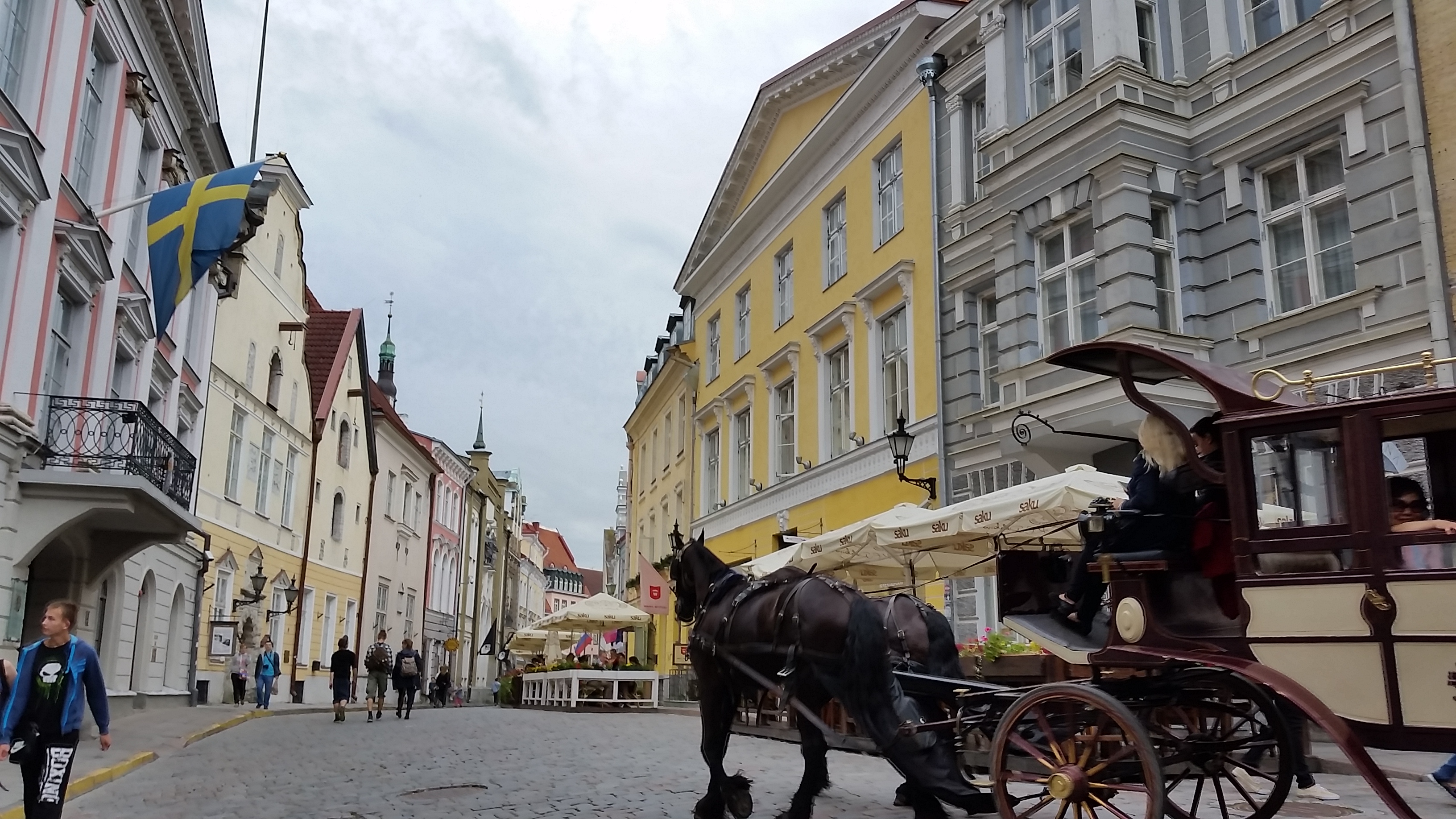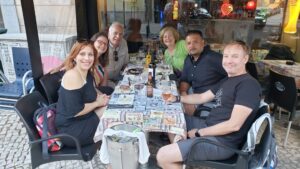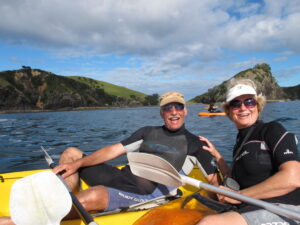During our six month stay in the Baltic countries, we found charms aplenty. But the three capitals of these countries are the jewels in the northern European crown. Though beset with war and destruction for 1000 years, each now offers a modern European experience in a rich historical landscape.
In so many ways, they are similar: a smattering of medieval towers, walls and blasted fortresses; a profusion of baroque buildings and churches; vast central squares away from which cobblestone pedestrian streets wander about; a historical core ringed by 19th and 20th century buildings in various stages of dinginess; and more. Their old towns have each been honored as World Heritage Sites by UNESCO.
But we could not confuse them.
- Click to read about Riga’s distinctive architecture, cityscape and market.
- Click to read about Vilnius as the seat of empire, learning and religion.
- Click to read the full overview on the three capital cities of the Baltics.
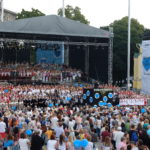
TALLINN can boast of a startling musical bounty, somewhat like that of Vilnius. In a country of a little over a million and a quarter people, about a third of whom live in Tallinn, it seems that everyone wants to break out in song, not just to make music, but to affirm their bonds with their fellow countrymen. That’s the impetus for the epic song festival every five years, days and days of choral competition playing to 100,000 or so. They even call their declaration of independence, and peaceful break from the Soviet Union in 1991, the “Singing Revolution.”
Just south of town, Tallinn has its own major music academy surrounded by a hip district of narrow streets, cafes and such. Music festivals abound. And it seems that every day during the season brings a smorgasbord of concerts of all sorts.
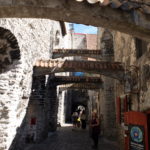
Otherwise, the old central city (Vanalinn) of Tallinn feels much more like a step back 400 to 600 years, for its streets are perhaps the most harmonious of all the Baltic jewels.
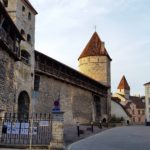
The old town is shaped like a rugby ball with the long axis going from the northeast near Tallinn’s harbor to the southwest and its suburbs. Many of the old walls and towers ring the rugby ball of the old town, most notably the part stretching from the southwestern edge of the city, with the looming Hermann tower and Toompea Castle’s 13th century walls and towers. The walls continue northward past three towers linked by wood arcaded walkways (where soldiers were stationed to protect the old town).

And then the walls round the northeastern edge of the city at the atmospheric Fat Margaret gate with its own triplet of towers. Outside these walls is all parkland and garden.
Within the walls, the streets form a medieval maze of twisting cobblestoned streets, joining and splitting at random and occasionally interrupted by a sizable plaza. Visitors pore over their maps in confusion; most seem lost or pleased to be so.
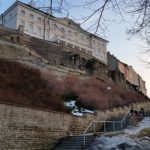
Wandering is even more difficult because the old town is divided geologically – and vertically – into two parts, with just a few ways to get from one to the other. The upper town floats on a granite escarpment, a rugby ball about a quarter of the size of the whole town tucked into its southwestern part. It’s a natural defensive barrier enhanced by the western walls. Buildings up here have more of a refined, baroque character. Even its dominant feature, across from Toompea Castle, seems much older: a stunning late 19th century Russian Orthodox church named for Tsar Alexander Nevsky.
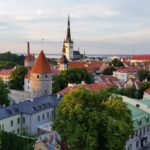
At several plazas along the northern and eastern edge of the escarpment, most enjoyably in the late light of day, you can savor an exhilarating view of the many steepled churches of the lower town toward the busy harbor and Baltic Sea.
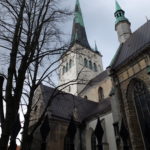
The most notable church is steeply peaked Oleviste, dating from the 12th century, yet more a hybrid of the middle ages and 18th century now. Though diminished from that time when it was rebuilt, the church had reputedly been the tallest structure in the world for a half century or so in the middle of the 13th century.
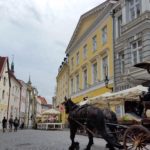
Even now there are just a few ways to go between the upper town and the lower. After descending the stairs into parkland at the north end, you can head to the main square along any number of cobbled streets like Numme or Pikk past medieval structures, pastel facades and guild halls – such as the House of the Blackheads or the Unmarried Merchants.

Or take the other route behind Nevsky Cathedral, near another set of arcaded towers and the bastion museum of Kiek in de Kok. There, you can descend steeply along the escarpment or take the stairs of the crooked Luhike lane toward old Niguliste church, one of the victims of the WW2 bombing and now reconstructed as a museum.
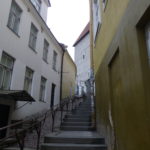
Nearby is the one section of the city that suffered irreparably from that destruction, now a large plaza and garden, as well as a broad straight passage to the center of the lower town.
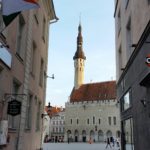
In the lower town, the medieval city returns with its gargoyle-decorated, Gothic town hall, very much 15th century despite subsequent modifications. Atop is still a metal weathervane of the town’s mascot, Old Thomas, and you can climb its spire for the best view of the whole town, as well as the central plaza elegantly fronted by medieval and baroque buildings – plus myriad restaurants. Any lane out of the plaza returns you to the maze of its old streets.
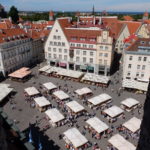
Outside of the center, in contrast to the river towns of Riga and Vilnius, Tallinn boasts a long seashore and harbor area. Baltic cruise ships and ferries connect Tallinn to Stockholm, Helsinki and St. Petersburg bringing some 2 million visitors per year to boost the economy.
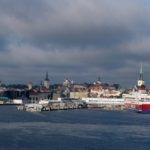
The harbor itself is a busy place, a work in progress with new malls still displacing old warehouses. Head east or west from the harbor along the shore of the Baltic Sea, though, for the real pleasure, kilometer after kilometer of parkland, beaches and bike trails.
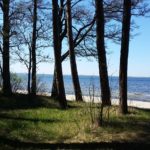
As Tallinn sprawls away from the water, the city does not quite measure up to the beauty of its rival towns, with humdrum apartment buildings and unimaginative modern buildings, perhaps because of the closer Soviet control till the 90s. Yet, here and there, it boasts an extraordinary collection of delicately trimmed, elongated wooden apartment buildings hundreds of years old, with whole streets sometimes full of them.

A less obvious legacy from the Soviet period, one you’d never realize from the town’s exquisite antiquity, is its capabilities in technology. As the story goes, Tallinn in Soviet Estonia was chose to set up hackers to monitor and break into western computing systems for information and whatever else they thought of use. After the Communist break up, this talent started a burgeoning tech center as it moved into more legitimate activity. The result was Skype, among other applications. Not bad for a medieval town.
(Also, for more pictures from Estonia and the Baltics, CLICK HERE to view the slideshow at the end of the Baltics itinerary page.)


